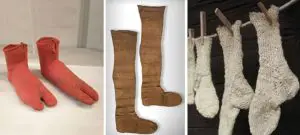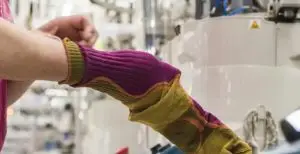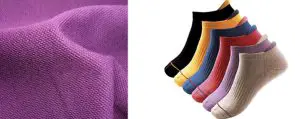Did you know socks have been worn since the Stone Age? They have evolved over time with new inventions, and now they are an important part of the fashion statement- designer brands cost a lot of money.
You also can’t do without socks because they keep you warm, protect your feet and absorb sweat.
However, many people are not aware of the intensive process of making socks.
In this article, you’ll learn the process of manufacturing socks, materials to use, mass production of socks, where they’re manufactured, and all there is to learn about socks making.
History of Socks

In the early years, socks were made of animal skin or hair. They were tied around the ankle or paired with a pair of sandals to prevent cold and exposure to infections.
In the 8th Century, Ancient Egyptians wore colorful socks made of wool, while the Greeks used animal hair to make warm socks. The Romans were not left out either; they wore socks made of woven fabric or leather.
The invention of knitting machines towards the end of the 15th century transformed socks from hand-knitted to modern socks, which are the machine knitted.
How Socks are Made Today?
Today, socks are produced in mass in factories with little or no manual effort thanks to further innovations in machines and materials.
You can now get whatever type of sock you desire: athletic socks, school socks, fluffy socks, winter socks, stockings, or simply for aesthetic purposes.
Plus, they are available in varied materials: from woolen to cotton to synthetic ones. The socks now have a better shape, and they fit your feet without slipping off. In addition, they are available in different thicknesses and lengths( knee-length, medium height, and ankle socks).
The Process of Making Socks

Socks are manufactured using knitting machines, but it follows a detailed seven-step manufacturing process: research, coding, yarn preparation, knitting, sewing, wash and dry, and boarding and pairing.
After a thorough research for designs, professionals develop a pattern that they draw in vector software, then it’s translated into a bitmap design. The bitmap image guides in creating a program (coding) that the knitting machine can understand.
A specific code is developed for each bitmap image to give the machine a set of instructions to produce the same socks.
The raw material is then prepared into yarns. The yarns are then dyed in different colors, and then the knitting process begins.
Numerous needles on the machine work fast to create interlocking loops, which then form a tube. The machine then sews the toe side of the tube to close it.
Once done, they are washed with water only to remove dirt and grease and prevent shrinkage. The socks are then shaped using metal in a process that involves heat to form the heel part.
After, they are steamed to soften the sock and maintain its shape. Next, socks are left to dry naturally.
Later they are inspected for defects while pairing them together. Finally, if the quality is assured, they are labeled and packaged ready for shipping.
How Are Mass-Produced Socks Made?
Socks are produced in large volumes at factories using specially designed machines that are either fully automated or semi-automated. The machines work fast to produce tones of socks in record time.
A circular knitting machine with the help of a coding system is used to produce socks in mass. The coding system takes care of the pattern, size, length, and color so that all socks of the same design are identical.
The machine has needles that create a series of loops that make a tube. Afterward, one end of the tube is sewed to close it then the tube is passed through a hot metal foot frame to give it a sock shape. The machine produces socks in sets of pairs for both the right and left feet.
From there, the socks are sorted according to feet size, length, and gender then packaged for distribution.
What Materials Are Socks Made of?

What determines the material of making socks is the functionality and design.
While you can use a single material, the best ones result from combining two or more materials to form a superior yarn.
The materials range from natural to synthetic. Wool (obtained from animal hair), cotton ( grown as a crop), and polyester are natural materials.
However, polyester is also synthetically produced by combining plastic and natural fibers. Spandex is a synthetic fiber made through a dry spinning method. It’s an elastic fiber that can stretch.
The different materials help achieve different results in making socks because they have different characteristics. Spandex helps make the sock elastic, while silk, bamboo, and cashmere make the sock soft.
Wool adds some warmth while cotton absorbs sweat. Polyester and other synthetic materials produce a quick-drying sock and anti-slip from your feet.
Where Are Socks Manufactured?
Socks are manufactured in factories located across the world. China, America, Italy, South Korea, Pakistan, Japan, and Turkey are the leaders in sock production, with China producing about 80% of all the socks.
Italy has fully automated machines while the Asian countries still use semi-automated machines. America produces functional socks, while cotton socks come from China because China is the greatest cotton producer.
How Do I Make My Own Socks?
Did you know you can make your own socks? There are several ways to do it: you can have your design custom made at a factory, knit by yourself using yarn and needles, or stitch from a fabric.
To make one, you need a stretchy fabric that is comfortable and easy to wear, a template(old sock), pair of scissors, pins, and a sewing machine or needle and thread. The following is the process:
- Place the fabric on a flat surface
- Trace the old sock on the fabric
- Cut the fabric according to the shape. Cut out four pieces
- Hold a pair of the cut out inside out (printed side inside). Use pins to secure at the top and bottom
- Sew around the edges in zigzag stitches
- Turn it so that the seams are on the inside
- Wash the sock
Socks FAQs:
Here are some frequently asked questions about how socks are made:
How Are Cotton Socks Made?
They are made by knitting twisted cotton yarn either by machine or hand. However, a 100% cotton sock is uncomfortable because cotton is not elastic and might not last long. Hence cotton is blended with spandex to add some stretch; wool, or cashmere in a mercerization process.
What Are Fluffy Socks Made Out of?
Fluffy socks are made of a material that is a blend of two-thirds polyester to one-third spandex. The material is elastic and extremely soft. It takes the shape of your feet without feeling tight.
The socks are fluffy; hence they are warm and feel good, especially when you walk barefoot in the house.
What Are Bamboo Socks Made of?
They are made of tightly woven bamboo fabric. It is soft and comfortable to the skin, like cotton.
Bamboo leaves, trunk, and inner pith are crushed then the pulp is mixed with some chemicals to form bamboo threads that you then spin into bamboo yarn.
Bamboo has antibacterial properties, so the sock helps to kill harmful bacteria that cause a bad odor.
How Are Seamless Socks Made?
Seamless socks are socks that don’t have a visible seam around the toe area. The seam is flat, and you can hardly feel it. The seams can be irritating for children and arthritic feet. Socks machines knit socks into a hollow tube; then, it’s seamed at the toe to close it.
For a seamless sock, a machine is used to close the toe side using a hand-linking method. The machine uses the same thread that made the sock form a flat link.
What Are Soccer Socks Made of?
Athletes put on special socks because of the rigorous physical exercise. Hence soccer socks are made of strong, durable material that provides comfort and protection. The material is also breathable and dries quickly to keep the feet dry.
Most soccer socks are made of polyester, spandex, nylon, cotton, bamboo, and synthetic yarns that blend several materials. Some soccer socks incorporate a shin guard to support the ankle and protect the leg from injuries.
Materials that prevent bacterial and fungal growth are also blended with the yarn because athletes get sweaty.
What Are School Socks Made of?
School socks are made of a blend of various materials because they are worn regularly and for long hours. They need to be comfortable, keep your feet dry or warm and support your feet during physical exercise.
The common materials are: combed cotton because it’s breathable, soft, absorbs sweat, is odor-free, and skin-friendly; polyester is combined with cotton (polycotton) because of polyester.
It is easy to wash quick-drying- when cotton absorbs sweat, polyester ensures it dries quickly, holds the fabric’s color well, doesn’t shrink like cotton. Combining the two makes soft, breathable, shrink-free socks and sweat absorbing. Other materials are wool for warmth and spandex ( elastane/ lycra) for elasticity.
Conclusion
Socks are made of different materials, lengths, and designs to fit your needs. Whether you want soccer socks, school socks, seamless socks, socks for eczema-prone skin, or want to feel warmth and comfort, there are numerous socks that you can choose from. Alternatively, you can custom make your sock designs now that you’ve learned how socks are made.

